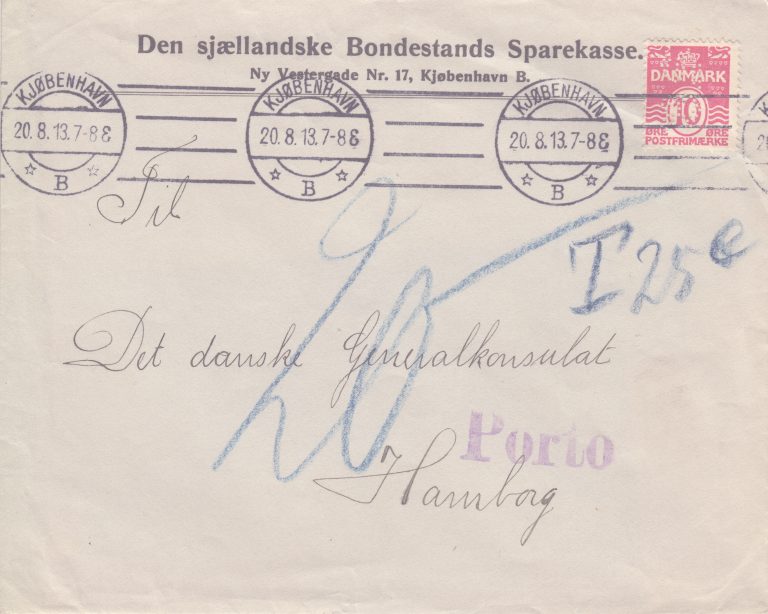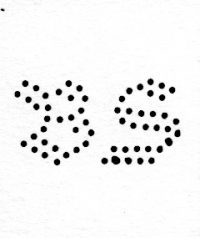B43.5 Den sjællandske Bondestands Sparekasse

International letter with perfin “BS” in the stamp. The letter is not franked correctly with 10 øre, the rate for International letters from October 1st 1907 to January 31th 1921 was 20 øre, there is 10 øre missing. The fee for this missing 10 øre was the double 20 øre, which can be seen written with blue chalk. The stamp is cancelled August 20th 1913 with Whole letter cancelation machine type SP. 4H. *B.* Bro. III.
This documentation for perfin BS is the only known so far and also the latest known date of use.
B 43.5 Den sjællandske Bondestands Sparekasse
Den sjællandske Bondestands Sparekasse
Ny Vestergade 17
1471 København V (B)

“BS” has been seen used in the period from June 1912 to August 1913
Needles
30 31
Known positions
| * | * | * | * |
| * | * | * | * |
Green indicates the Perfin position on the current item.
Den Sjællandske Bondestands Sparekasse was a Danish savings bank which was opened in 1856 in order to help farmers obtain loans at a low interest rate in order that they could buy their own lands.
The savings bank was founded at the initiative of farm owner Jørgen Christensen (1831-1863) from Kirke Stillinge with the support of Carl Christian Alberti who was chairman of the board from the beginning and until his death in 1890.
The destiny of the bank was closely knit together with Alberti’s son Peter Adler Alberti, who in 1875 took over his father’s position of trust in Den Sjællandske Bondestands Sparekasse, which at that time was Denmark’s second largest financial institution. Alberti followed his father as chairman of the board in 1890. In 1908 it became clear that Alberti had committed fraud of 14.7 million Danish Kroner and falsified the bank’s books.
After the fraud, the bank was reconstructed by the Revisionsbanken, later Deloitte.
The Savings Bank in 1968 became Sparekassen Sjælland and later a part of Sparekassen SKS og then again Sparekassen SDS, which in 1990 became part of Unibank. In 2000 Unibank was taken over by Nordea.
Many of those familiar with Danish history would ask the question: “Was it that Alberti?” And, yes, it was, hence a bit more history:
Peter Adler Alberti was born on June 10th, 1851, and died on June 14th, 1932. He was a Danish politician and swindler who was known for the Alberti scandal from 1908.
Alberti was a laywer and the son of a highly respected liberal politician who had been a pioneer within the Danish savings bank system. Alberti had made his career which had led him to leading Den Sjællandske Bondestands Sparekasse from 1890. However, very early Alberti became involved in speculations and doubtful financial transactions – partly because of his ludomania. Later it turned out that he was guilty of serious embezzlement from a very early stage on.
Perhaps in order to prevent further accusations, he entered politics in 1892 as a representative of the liberal movement.
During the years from 1901 till 1908 Alberti was Denmark’s minister of justice and he turned out to be a clever and effective politician, who, however, also was described as authoritarian and brash. During his time as minister he was constantly accused of financial misdoings by right and left wing parties. Prime minister J.C. Christensen ignored the critics; but he finally had to ask Alberti to withdraw from his post.
A few months later, Alberti handed him self over to the police and confessed an embezzlement which would in to-day’s currency correspond to approx. 1.1 billion Danish Kroner. Alberti was later sentenced to 8 years jail and spent the years 1912 to 1917 in prison. After his release, Alberti lived a quiet life. Alberti died on June 14th, 1932, in a traffic accident.
Written by Thomas Sørensen in 2015. Translated/adapted by Morten Mikkelsen.